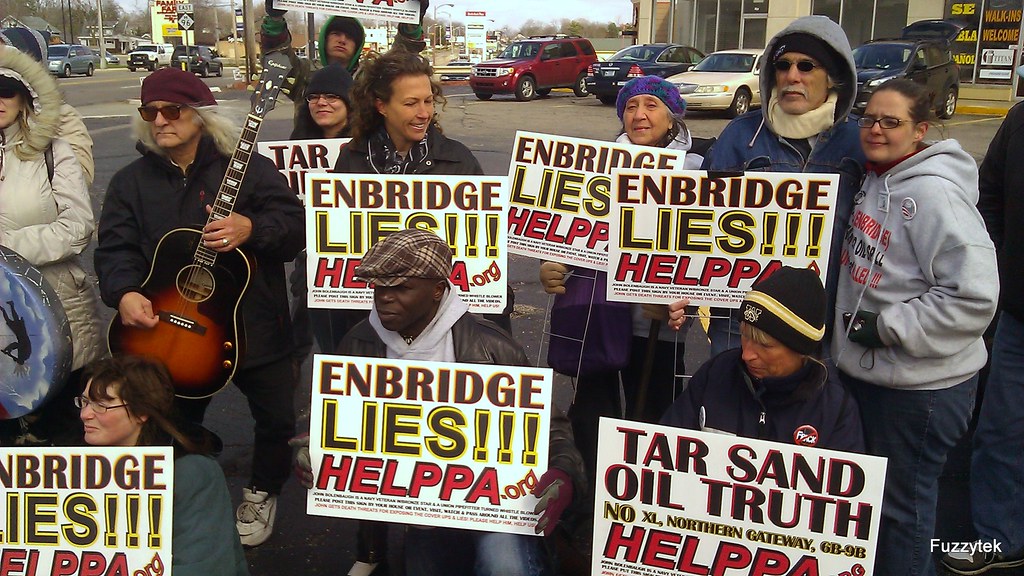CRUS Director Tyler Norman visited a blockade camp in Northern Minnesota. Corporate criminals at Enbridge are currently building “Line 3,” a pipeline which would carry nearly 1 million gallons/day of a partially-refined oil-like product from the world’s most destructive and inefficient source of petroleum in Alberta, Canada… pumped 1,100 miles across precious Northwoods wetlands, sacred wild rice beds, and abundant wildlife habitats… eventually to the Great Lakes where the pipeline terminates at an antiquated port in Superior, Wisconsin.
There this exceptionally corrosive and dangerous product called “diluted bitumen” or “dilbit” will be loaded onto ships to be transported to refineries on the Gulf Coast or abroad.
Every step of this path is exceedingly risky. Enbridge is responsible for the Number 1 and Number 2 biggest inland oil spills in US history. In 2010, Line 6B ruptured in Kalamazoo, Michigan, spilling over 1 million gallons of dilbit into Talmadge Creek. After a 5-year clean-up effort, experts lamented that most of the heavy substance had sank into the stream bed and was impossible to remove, so now it just gradually leaches out into the creek and everything downstream. In 1991, the old Line 3 ruptured near Grand Rapids, Minnesota, spilling 1.7 million gallons of crude oil.
Luckily, in winter the marsh was frozen solid under the pipe, so the spill was relatively easy to clean. But this fact points out the stupidest aspect of the plan to rebuild Line 3. Locals can show visitors many locations where the old pipeline, originally buried several feet under these wetland ecosystems, has floated up to the surface, arcing out of the earth like a rusty spine. Leaks in these exposed areas are inevitable. Enbridge uses these leaks as justification for building their new pipeline through the same areas (another, seen on a TV ad, is that without Line 3 Enbridge must burn even more fossil fuels transporting dilbit by truck – what a load of corporate blackmail crap!).
Communities are fighting not only Line 3, but also Line 5 in Michigan and Line 9 in Ontario. All carry dilbit from the Alberta Tar Sands, a practice which has faced widespread opposition from its inception. These unbelievably giant mining projects (visible from space!) are the final decadent indulgence of a dying fossil fuel industry. Including refineries powered by fracked gas, sprawling toxic waste ponds, and a continental spiderweb of pipelines, tar sands extraction creates an enormous infrastructure for making gargantuan profits, even as its bottom-of-the-barrel product consumes nearly as much energy as it provides.
The fight against Line 3 is one that we can win. Recent indigenous-led campaigns have succeeded in stopping another pipeline and an open-pit iron mine in the region. Local Ojibwe Water Protectors have been fighting this pipeline for 7 years, and they have a plan. There are multiple camps in the pathway of Line 3. Water Protectors slowed construction throughout 2020, but now is their final stand, to stop the construction of the pipeline before it goes under the headwaters of the Mississippi River. They intend to host more than 1,000 people in June, all participating in massive civil disobedience to stop this harmful and unnecessary extraction infrastructure.
Join this important struggle! If you want action – everyone is invited to the Treaty People Gathering June 5-8. Or there are plenty of other opportunities for participation – see StopLine3.org for more info.
Photo credit: “Mark @ Battle Creek” by Fuzzytek is licensed under CC BY-NC-ND 2.0

